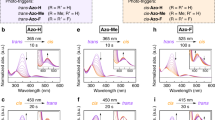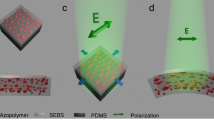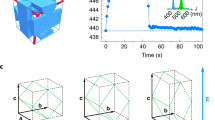Abstract
An increase in random molecular vibrations of a solid owing to heating above the melting point leads to a decrease in its long-range order and a loss of structural symmetry. Therefore conventional liquids are isotropic media. Here we report on a light-induced isothermal transition of a polymer film from an isotropic solid to an anisotropic liquid state in which the degree of mechanical anisotropy can be controlled by light. Whereas during irradiation by circular polarized light the film behaves as an isotropic viscoelastic fluid, it shows considerable fluidity only in the direction parallel to the light field vector under linear polarized light. The fluidization phenomenon is related to photoinduced motion of azobenzene-functionalized molecular units, which can be effectively activated only when their transition dipole moments are oriented close to the direction of the light polarization. We also describe here how the photofluidization allows nanoscopic elements of matter to be precisely manipulated.
This is a preview of subscription content, access via your institution
Access options
Subscribe to this journal
Receive 12 print issues and online access
$259.00 per year
only $21.58 per issue
Buy this article
- Purchase on Springer Link
- Instant access to full article PDF
Prices may be subject to local taxes which are calculated during checkout





Similar content being viewed by others
References
Ashkin, A. Optical trapping and manipulation of neutral particles using lasers. Proc. Natl Acad. Sci. USA 94, 4853–4860 (1997).
Chu, S. The manipulation of neutral particles. Rev. Mod. Phys. 70, 685–706 (1998).
Kuhr, S. et al. Deterministic delivery of a single atom. Science 293, 278–280 (2001).
Manuz, P. et al. Cavity cooling of a single atom. Nature 428, 50–52 (2004).
Feurer, T., Vaughan, J. C. & Nelson, K. A. Spatiotemporal coherent control of lattice vibrational waves. Science 299, 374–377 (2003).
Auld, B. A. Acoustic Fields and Waves in Solid (Krieger, Malabar, Florida, 1990).
Fillard, J. P. Near Field Optics and Nanoscopy (World Scientific, Singapore, 1996).
Balykin, V. I., Klimov, V. V. & Letokhov, V. S. Laser near field lens for atoms. J. Phys. II 4, 1981–1997 (1994).
Pohl, D. W. in Forces in Scanning Probe Methods (eds Güntherodt, H. -J., Anselmetti, D. & Meyer, E.) 235–248 (NATO Advanced Study Institutes, Ser. E, Vol. 286, Kluwer, Dordrecht, 1995).
Novotny, L., Bian, R. X. & Xie, X. S. Theory of nanometric optical tweezers. Phys. Rev. Lett. 79, 645–648 (1997).
Kottmann, J. P., Martin, O. J. F., Smith, D. R. & Schultz, S. Non-regularly shaped plasmon resonant nanoparticle as localized light source for near-field microscopy. J. Microsc. 202, 60–65 (2001).
Rau, H. in Photochemistry and Photophysics Vol. 2 (ed. Rabek, J. F.) 119–141 (CRC, Boca Raton, Florida, 1990).
Hampson, G. C. & Robertson, J. M. Bond lengths and resonance in the cis-azobenzene molecule. J. Chem. Soc. 409–413 (1941).
Brown, C. J. A refinement of the crystal structure of azobenzene. Acta Crystallogr. 21, 146–152 (1966).
Natansohn, A. & Rochon, P. Photoinduced motions in azo-containing polymers. Chem. Rev. 102, 4139–4175 (2002).
Vismanathan, N. K. et al. Surface relief structures on azo polymer films. J. Mater. Chem. 9, 1941–1955 (1999).
Barrett, C. J., Rochon, P. L. & Natansohn, A. L. Model of laser-driven mass transport in thin films of dye-functionalized polymers. J. Chem. Phys. 109, 1505–1516 (1998).
Kumar, J. et al. Gradient force: The mechanism for surface relief grating formation in azobenzene functionalized polymers. Appl. Phys. Lett. 72, 2096–2098 (1998).
Sumarua, K., Yamanaka, T., Fukuda, T. & Matsuda, H. Photoinduced surface relief gratings on azopolymer films: Analysis by a fluid mechanics model. Appl. Phys. Lett. 75, 1878–1880 (1999).
Geue, T. M. et al. Formation mechanism and dynamics in polymer surface gratings. Phys. Rev. E 65, 052801 (2002).
Natansohn, A., Rochon, P., Gosselin, J. & Xie, S. Azo polymers for reversible optical storage. 1. Poly[4′ -[[2-(acryloyloxy)ethyl]ethylaminol-4-nitroazobenzene]. Macromolecules 25, 2268–2273 (1992).
Mechau, N., Neher, D., Börger, V., Menzel, H. & Urayama, K. Optically driven diffusion and mechanical softening in azobenzene polymer layers. Appl. Phys. Lett. 81, 4715–4717 (2002).
Kobayashi, T., Degenkolb, E. O. & Rentzepis, P. M. Picosecond Spectroscopy of 1-Phenylazo-2-hydroxynaphthalene. J. Phys. Chem. 83, 2431–2434 (1979).
Stiller, B. et al. Scanning Kelvin microscopy as a tool for visualization of optically induced molecular switching in azobenzene self assembling films. Surf. Interface Anal. 30, 549–551 (2000).
Karageorgiev, P. et al. Modification of the surface potential of azobenzene-containing Langmuir-Blodgett films in the near field of a scanning Kelvin microscope tip by irradiation. Langmuir 16, 5515–5518 (2000).
Yager, K. G. & Barrett, C. J. Temperature modelling of laser-irradiated azo-polymer thin films. J. Chem. Phys. 120, 1089–1096 (2004).
VanLandingham, M. R., Villarrubia, J. S., Guthrie, W. F. & Meyers, G. F. in Advances in Scanning Probe Microscopy of Polymers (eds Tsukruk, V. V. & Spencer, N. D.) 15–43 (Macromol. Symp. 2001, Vol. 167, Wiley-VCH, Weinheim, 2001).
Sperling, L. H. Introduction to Physical Polymer Science 2nd edn (Wiley, New York, 1992).
Sane, S. B. & Knauss, W. G. On interconversion of various material functions of PMMA. Mech. Time-Depend. Mater. 5, 325–343 (2001).
Ting, T. C. T. The contact stress between a rigid indenter and viscoelastic half-space. J. Appl. Mech. 33, 845–854 (1966).
Barrett, C. J., Natansohn, A. L. & Rochon, P. L. Mechanism of optically inscribed high-efficiency diffraction gratings in azo polymer films. J. Phys. Chem. 100, 8836–8842 (1996).
Todorov, T., Nikolova, L. & Tomova, N. Polarization holography. 1: A new high-efficiency organic material with reversible photoinduced birefringence. Appl. Opt. 23, 4309–4312 (1984).
Sekkat, Z. et al. Light-induced orientation in a high glass transition temperature polyimide with polar azo dyes in the side chain. J. Opt. Soc. Am. B 13, 1713–1724 (1996).
Camacho-Lopez, M., Finkelmann, H., Palffy-Muhoray, P. & Shelley, M. Fast liquid-crystal elastomer swims into the dark. Nature Mater. 3, 307–310 (2004).
Ikawa, T. et al. Optical near field induced change in viscoelasticity on an azobenzene-containing polymer surface. J. Phys. Chem. B 104, 9055–9058 (2000).
Bozhevolnyi, S. I. & Vohnsen, B. Near-field optics with uncoated fiber tips: light confinement and spatial resolution. J. Opt. Soc. Am. B 14, 1656–1663 (1997).
Fukuda, T. et al. Observation of optical near-field as photo-induced surface relief formation. Jpn J. Appl. Phys. 40, L900–L902 (2001).
Royer, P., Barchiesi, D., Lerondel, G. & Bachelot, R. Near-field optical pattering and structuring based on local-field enhancement at the extremity of a metal tip. Phil. Trans. R. Soc. Lond. A 362, 821–842 (2004).
Karageorgiev, P., Stiller, B. & Brehmer, L. Verfahren zum optischen Induzieren eines Massetransports. DE Patent 10234012A1 (2002).
Watanabe, O. et al. Transcription of near-field induced by photo-irradiation on a film of azo-containing urethane-urea copolymer. Mol. Cryst. Liq. Cryst. 345, 305–310 (2000).
Acknowledgements
We thank J. Stumpe for discussions, K. Morawetz and O. Henneberg for the preparation of samples, A. Kosiorek and W. Kandulski for the SEM images of the probe tips. P.K. thanks V. Karageorgieva for encouragement during the experimental work and assistance with preparing the manuscript, and S. Schrader for support. The Ministerium für Wissenschaft, Forschung und Kultur of Brandenburg funded this work.
Author information
Authors and Affiliations
Corresponding author
Ethics declarations
Competing interests
The authors declare no competing financial interests.
Supplementary information
Supplementary Information
Supplementary figures S1 - S5 (PDF 275 kb)
Rights and permissions
About this article
Cite this article
Karageorgiev, P., Neher, D., Schulz, B. et al. From anisotropic photo-fluidity towards nanomanipulation in the optical near-field. Nature Mater 4, 699–703 (2005). https://doi.org/10.1038/nmat1459
Received:
Accepted:
Published:
Issue Date:
DOI: https://doi.org/10.1038/nmat1459
This article is cited by
-
Polarization-driven reversible actuation in a photo-responsive polymer composite
Nature Communications (2023)
-
Enhancement of molecular mobility in solid polymers by light: fundamentals and applications
Applied Physics B (2022)
-
Topographical transition of submicron pillar array of azo molecular glass induced by circularly polarized light
Scientific Reports (2021)
-
Photoinduced Reversible Solid-to-Liquid Transitions and Directional Photofluidization of Azobenzene-containing Polymers
Chinese Journal of Polymer Science (2021)
-
Nanoimprint lithography for high-throughput fabrication of metasurfaces
Frontiers of Optoelectronics (2021)



